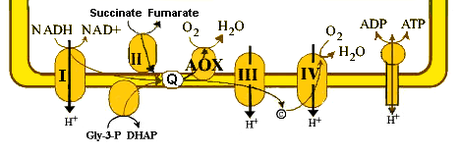
Alternative oxidase
Encyclopedia

Electron transport chain
An electron transport chain couples electron transfer between an electron donor and an electron acceptor with the transfer of H+ ions across a membrane. The resulting electrochemical proton gradient is used to generate chemical energy in the form of adenosine triphosphate...
in plant
Plant
Plants are living organisms belonging to the kingdom Plantae. Precise definitions of the kingdom vary, but as the term is used here, plants include familiar organisms such as trees, flowers, herbs, bushes, grasses, vines, ferns, mosses, and green algae. The group is also called green plants or...
s, as well as some fungi
Fungus
A fungus is a member of a large group of eukaryotic organisms that includes microorganisms such as yeasts and molds , as well as the more familiar mushrooms. These organisms are classified as a kingdom, Fungi, which is separate from plants, animals, and bacteria...
, protist
Protist
Protists are a diverse group of eukaryotic microorganisms. Historically, protists were treated as the kingdom Protista, which includes mostly unicellular organisms that do not fit into the other kingdoms, but this group is contested in modern taxonomy...
s and possibly some animal
Animal
Animals are a major group of multicellular, eukaryotic organisms of the kingdom Animalia or Metazoa. Their body plan eventually becomes fixed as they develop, although some undergo a process of metamorphosis later on in their life. Most animals are motile, meaning they can move spontaneously and...
s. Sequences similar to the plant oxidase have also been identified in bacteria
Bacteria
Bacteria are a large domain of prokaryotic microorganisms. Typically a few micrometres in length, bacteria have a wide range of shapes, ranging from spheres to rods and spirals...
l genomes.
The oxidase provides an alternative route for electrons passing through the electron transport chain to reduce oxygen. However, as several proton
Proton
The proton is a subatomic particle with the symbol or and a positive electric charge of 1 elementary charge. One or more protons are present in the nucleus of each atom, along with neutrons. The number of protons in each atom is its atomic number....
-pumping steps are bypassed in this alternative pathway, activation of the oxidase reduces ATP generation. This enzyme was first identified as a distinct oxidase pathway from cytochrome c oxidase
Cytochrome c oxidase
The enzyme cytochrome c oxidase or Complex IV is a large transmembrane protein complex found in bacteria and the mitochondrion.It is the last enzyme in the respiratory electron transport chain of mitochondria located in the mitochondrial membrane...
as the alternative oxidase is resistant to inhibition
Enzyme inhibitor
An enzyme inhibitor is a molecule that binds to enzymes and decreases their activity. Since blocking an enzyme's activity can kill a pathogen or correct a metabolic imbalance, many drugs are enzyme inhibitors. They are also used as herbicides and pesticides...
by the poison cyanide
Cyanide
A cyanide is a chemical compound that contains the cyano group, -C≡N, which consists of a carbon atom triple-bonded to a nitrogen atom. Cyanides most commonly refer to salts of the anion CN−. Most cyanides are highly toxic....
.
Function

Metabolic pathway
In biochemistry, metabolic pathways are series of chemical reactions occurring within a cell. In each pathway, a principal chemical is modified by a series of chemical reactions. Enzymes catalyze these reactions, and often require dietary minerals, vitamins, and other cofactors in order to function...
leading to the alternative oxidase diverges from the cytochrome-linked electron transport chain at the ubiquinone pool. Alternative pathway respiration only produces proton translocation at Complex 1 (NADH dehydrogenase) and so has a lower ATP
Adenosine triphosphate
Adenosine-5'-triphosphate is a multifunctional nucleoside triphosphate used in cells as a coenzyme. It is often called the "molecular unit of currency" of intracellular energy transfer. ATP transports chemical energy within cells for metabolism...
yield than the full pathway. The expression of the alternative oxidase gene AOX is influenced by stresses such as cold, reactive oxygen species
Reactive oxygen species
Reactive oxygen species are chemically reactive molecules containing oxygen. Examples include oxygen ions and peroxides. Reactive oxygen species are highly reactive due to the presence of unpaired valence shell electrons....
and infection by pathogens, as well as other factors that reduce electron flow through the cytochrome pathway of respiration. Although the benefit conferred by this activity remains uncertain, it may enhance an organisms' ability to resist these stresses, through reducing the level of oxidative stress
Oxidative stress
Oxidative stress represents an imbalance between the production and manifestation of reactive oxygen species and a biological system's ability to readily detoxify the reactive intermediates or to repair the resulting damage...
.
Unusually, the bloodstream form of the protozoan parasite Trypanosoma brucei
Trypanosoma brucei
Trypanosoma brucei is a parasitic protist species that causes African trypanosomiasis in humans and nagana in animals in Africa. There are 3 sub-species of T. brucei: T. b. brucei, T. b. gambiense and T. b. rhodesiense.These obligate parasites have two hosts - an insect vector and mammalian host...
, which is the cause of sleeping sickness, depends entirely on the alternative oxidase pathway for cellular respiration through its electron transport chain. This major metabolic difference between the parasite and its human host
Host (biology)
In biology, a host is an organism that harbors a parasite, or a mutual or commensal symbiont, typically providing nourishment and shelter. In botany, a host plant is one that supplies food resources and substrate for certain insects or other fauna...
has made the T. brucei alternative oxidase an attractive target for drug design
Drug design
Drug design, also sometimes referred to as rational drug design or structure-based drug design, is the inventive process of finding new medications based on the knowledge of the biological target...
. Of the known inhibitors of alternative oxidases, the antibiotic ascofuranone
Ascofuranone
Ascofuranone is an antibiotic produced by the fungus Ascochyta visiae. that inhibits the Trypanosoma brucei alternative oxidase and is a lead compound in efforts to produce other drugs targeting this enzyme for the treatment of sleeping sickness...
inhibits the T. brucei enzyme and cures infection in mice.
In fungi, the ability of the alternative oxidase to bypass inhibition of parts of the electron transport chain can contribute to fungicide
Fungicide
Fungicides are chemical compounds or biological organisms used to kill or inhibit fungi or fungal spores. Fungi can cause serious damage in agriculture, resulting in critical losses of yield, quality and profit. Fungicides are used both in agriculture and to fight fungal infections in animals...
resistance. This is seen in the strobilurin
Strobilurin
Strobilurins are a group of chemical compounds used in agriculture as fungicides. They are part of the larger group of QoI inhibitors, which act to inhibit the respiratory chain at the level of Complex III....
fungicides that target complex III
Coenzyme Q - cytochrome c reductase
In enzymology, a ubiquinol—cytochrome-c reductase is an enzyme that catalyzes the chemical reactionThus, the two substrates of this enzyme are dihydroquinone and ferri- cytochrome c, whereas its 3 products are quinone , ferro- cytochrome c, and H+.This enzyme belongs to the family of...
, such as azoxystrobin, picoxystrobin and fluoxastrobin. However, as the alternative pathway generates less ATP, these fungicides are still effective in preventing spore
Spore
In biology, a spore is a reproductive structure that is adapted for dispersal and surviving for extended periods of time in unfavorable conditions. Spores form part of the life cycles of many bacteria, plants, algae, fungi and some protozoa. According to scientist Dr...
germination, as this is an energy-intensive process.
Structure and mechanism
The alternative oxidase is an integral membrane proteinIntegral membrane protein
An integral membrane protein is a protein molecule that is permanently attached to the biological membrane. Proteins that cross the membrane are surrounded by "annular" lipids, which are defined as lipids that are in direct contact with a membrane protein...
that is tightly bound to the inner mitochondrial membrane. The enzyme has been predicted to contain a coupled diiron center on the basis of a conserved sequence motif consisting of the proposed iron ligands, four glutamine
Glutamine
Glutamine is one of the 20 amino acids encoded by the standard genetic code. It is not recognized as an essential amino acid but may become conditionally essential in certain situations, including intensive athletic training or certain gastrointestinal disorders...
and two histidine
Histidine
Histidine Histidine, an essential amino acid, has a positively charged imidazole functional group. It is one of the 22 proteinogenic amino acids. Its codons are CAU and CAC. Histidine was first isolated by German physician Albrecht Kossel in 1896. Histidine is an essential amino acid in humans...
amino acid residues. The electron spin resonance study of Arabidopsis thaliana
Arabidopsis thaliana
Arabidopsis thaliana is a small flowering plant native to Europe, Asia, and northwestern Africa. A spring annual with a relatively short life cycle, arabidopsis is popular as a model organism in plant biology and genetics...
alternative oxidase AOX1a showed that the enzyme contains a hydroxo-bridged mixed-valent Fe(II)/Fe(III) binuclear iron
Iron
Iron is a chemical element with the symbol Fe and atomic number 26. It is a metal in the first transition series. It is the most common element forming the planet Earth as a whole, forming much of Earth's outer and inner core. It is the fourth most common element in the Earth's crust...
center. A catalytic cycle
Enzyme catalysis
Enzyme catalysis is the catalysis of chemical reactions by specialized proteins known as enzymes. Catalysis of biochemical reactions in the cell is vital due to the very low reaction rates of the uncatalysed reactions....
has been proposed that involves this di-iron center and at least one transient protein-derived free radical, which is probably formed on a tyrosine
Tyrosine
Tyrosine or 4-hydroxyphenylalanine, is one of the 22 amino acids that are used by cells to synthesize proteins. Its codons are UAC and UAU. It is a non-essential amino acid with a polar side group...
residue.
See also
- MetalloproteinMetalloproteinMetalloprotein is a generic term for a protein that contains a metal ion cofactor. Metalloproteins have many different functions in cells, such as enzymes, transport and storage proteins, and signal transduction proteins. Indeed, about one quarter to one third of all proteins require metals to...
- Bioinorganic chemistryBioinorganic chemistryBioinorganic chemistry is a field that examines the role of metals in biology. Bioinorganic chemistry includes the study of both natural phenomena such as the behavior of metalloproteins as well artificially introduced metals, including those that are non-essential, in medicine and toxicology...
- CofactorCofactor (biochemistry)A cofactor is a non-protein chemical compound that is bound to a protein and is required for the protein's biological activity. These proteins are commonly enzymes, and cofactors can be considered "helper molecules" that assist in biochemical transformations....
External links
- Electron transport proteins
- InterPro entry on alternative oxidases
- Alternative respiration Root Research Introduction Virtual Course Seminar

